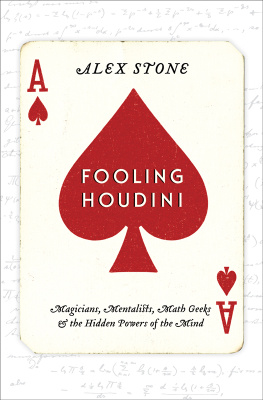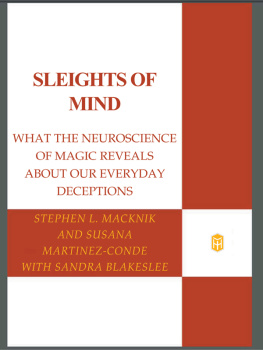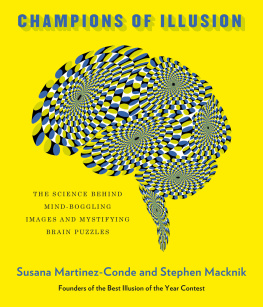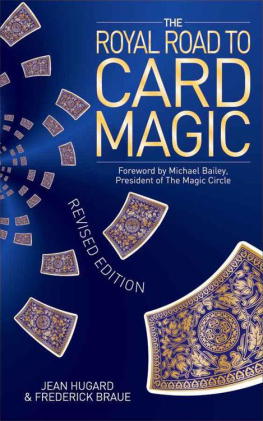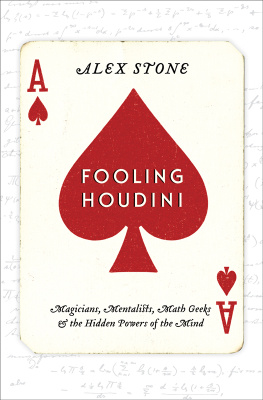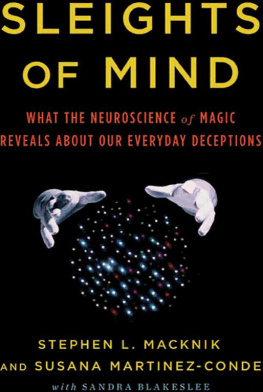Ive long wished that there was a book that explained the art of magic from the point of view of cognitive neuroscience. Magic is a goldmine of information about the brain, as well as a source of fascination to laypeople. This is the book weve all been waiting for. Steven Pinker, author of The Stuff of Thought
Magic is the place where our senses and beliefs fail us in magnificent ways. This exciting book explores what magic and illusions can teach us about our fallible human nature coming up with novel and fascinating observations. Dan Ariely, author of Predictability Irrational
Sleights of Mind gives non-magicians a real up-close look at the true secrets of magic They reveal the real knowledge jealously guarded by all great performers I know [my fellow magicians] are all going to be as jazzed as I am to read about how sophisticated magical techniques and state-of-the-art brain science combine. Mac King, headliner, Harrahs Las Vegas
Determined to explore those places where neuroscience intersects the mysterious and the magical, from visual illusions to Vegas card tricks, Steve and Susana are two of the most innovative scientists I know. This book doesnt just change the way you think about sleight of hand and David Copperfield it will also change the way you think about the mind. Jonah Lehrer, author of How We Decide and Proust Was A Neuroscientist
This is a highly original book. Science and magic have much in common. They both take seemingly inexplicable events and provide elegantly simple answers that enthral the observer. The authors have done an admirable job in exploring this idea and also suggest ways in which the two disciplines can cross fertilize each other. VS Ramachandran, author of Phantoms in the Brain
Stephen Macknik and Susana Martinez-Conde persistently remind us that the human mind is a bad data-taking device. And its this fact that enables the science of magic to exist at all. Neil deGrasse Tyson, author of The Pluto Files
Every professional magician will tell you that any great magic trick is based 90 percent on psychology. This groundbreaking book explores the convergence of magic and neuroscience and educates the reader in seemingly unrelated subjects in a way that is educational and entertaining! Lance Burton, magician
A terrific read. Combining science and magic is not an easy trick, but the authors have done a brilliant job of putting a mirror up to ourselves and our psyches. I loved it. Joe Navarro, author of What Every Body is Saying
SLEIGHTS OF MIND
STEPHEN L. MACKNIK, PH.D., is the director of the Laboratory of Behavioral Neurophysiology at the Barrow Neurological Institute in Phoenix, Arizona.
SUSANA MARTINEZ-CONDE, PH.D., is the director of the Laboratory of Visual Neuroscience at BNI.
DRS. MACKNIK AND MARTINEZ-CONDE are members of the Academy of Magical Arts (aka the Magic Castle in Hollywood), the Magic Circle (UK), the Society of American Magicians, and the International Brotherhood of Magicians.
SANDRA BLAKESLEE, who specializes in the brain sciences, is a regular contributor to the Science Times section of The New York Times and the author of several books.

SLEIGHTS OF MIND
WHAT THE NEUROSCIENCE of MAGIC
REVEALS ABOUT OUR BRAINS
Stephen L. Macknik
and Susana Martinez-Conde
with Sandra Blakeslee

First published in Great Britain in 2011 by
PROFILE BOOKS LTD
3A Exmouth House
Pine Street
London EC1R 0JH
www.profilebooks.com
First published in the United States of America in 2010 by
Henry Holt and Company, LLC
Copyright Stephen L. Macknik and Susana Martinez-Conde
1 3 5 7 9 10 8 6 4 2
Designed by Meryl Sussman Levavi
Printed and bound in Great Britain by
Clays, Bungay, Suffolk
The moral right of the authors has been asserted.
All rights reserved. Without limiting the rights under copyright reserved above, no part of this publication may be reproduced, stored or introduced into a retrieval system, or transmitted, in any form or by any means (electronic, mechanical, photocopying, recording or otherwise), without the prior written permission of both the copyright owner and the publisher of this book.
A CIP catalogue record for this book is available from the British Library.
ISBN 978 1 84668 389 3
eISBN 978 1 84765 295 9
The paper this book is printed on is certified by the 1996 Forest Stewardship Council A.C. (FSC). It is ancient-forest friendly. The printer holds FSC chain of custody SGS-COC-2061

To our wonderful children,
Iago and Brais.
Thank you for all the magic.
SLEIGHTS OF MIND

INTRODUCTION
CLARKES THIRD LAW: Any sufficiently advanced technology is indistinguishable from magic.
NIVENS LAW: Any sufficiently advanced magic is indistinguishable from technology.
AGATHA HETERODYNE (GIRL GENIUS) PARAPHRASE OF NIVENS LAW: Any sufficiently analyzed magic is indistinguishable from science!
H ave you ever wondered how magic effects work? Coins materialize out of thin air. Cards move through a deck as if pulled by an invisible force. Beautiful women are cut in half. Spoons bend. Fish, elephants, even the Statue of Liberty disappear before your eyes. How does a mentalist actually read your mind? How can you not see the gorilla in the room? Really, how can someone catch a bullet in his teeth? How do they do it?
Dont bother to ask a conjurer. When joining an organization of professional magicians, the initiate may be asked to take an oath: As a magician I promise never to reveal the secret of any illusion to a nonmagician, unless that person also swears to uphold the magicians oath. I promise never to perform any illusion for any nonmagician without first practicing the effect until I can do it well enough to maintain the illusion of magic. It is a code. A brotherhood. The magician who breaks this code risks being blackballed by his fellow magicians.
So what are we, a couple of muggles, doing writing a book on magic? Zipped lips aside, hasnt most everything about magic been revealed? Enter magic in the Amazon Books search box and 75,000 results pop up. Log in to YouTube and you can see just about every magic trick ever devisedoften demonstrated by darling seven-year-olds in their bedrooms with Mom or Dad wielding the videocam. Visit Craigslist and choose from myriad charming descriptions of local amateur magicians. Whats left to say?
Actually, plenty. This is the first book ever written on the neuro-science of magic, or, if you will, Much has been said about the history of magic, tricks of the trade, the latest props, and psychological responses to magical effects. But neuroscience probes more deeply. We want to pop the hood on your brain as you are suckered in by sleights of hand. We want to explain at a fundamental level why you are so thoroughly vulnerable to sleights of mind. We want you to see how deception is part and parcel of being human. That we deceive each other all the time. And that we survive better and use fewer brain resources while doing so because of the way our brains produce attention.
Next page




